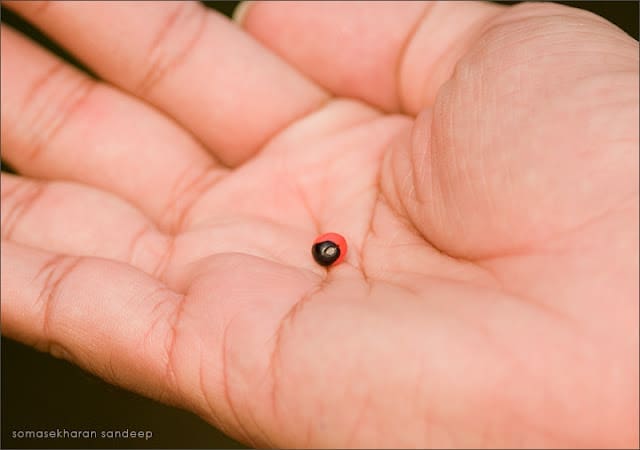Granddad had a box full of lovely red-and-black seeds (known in Malayalam as kunnikkuru), which he would distribute equally among the players. The game was to grab random handfuls and make the opponent guess if the count was even or odd. A correct guess corroborated after counting the seeds, would be rewarded with the entire handful being “won” and added to the guesser’s pile, and a wrong guess would mean surrendering the same number of seeds to the opponent. The game goes on till one player is out of seeds and becomes a pauper.
Granddad warned me the first day he taught me the game that at no cost should I eat the seeds or even put them in my mouth. I would vomit blood and die if it was ingested, he warned. Even though I didn’t believe it completely (my grandparents carried on about a lot of superstitious beliefs) I was never tempted to chew on one after hearing that.
Another memory of this seed is tied to the famous Guruvayur temple in Thrissur, Kerala. Inside the temple premises is a wide-brimmed vessel filled with these seeds. They are there for an interesting ritual: Kids are to grab a handful and drop it back in – this was believed to make them more mischievous. I was really disappointed that they made me drop the colorful seeds back into the vessel; I would have loved to carry some home!
 |
| A pod that has already burst open |
About 25 years later, I came upon a creeper at Polachira wetlands (near Thiruvananthapuram) that carried a pod that was just splitting open. From within peered five or six of those red peas. I came home immediately and tried to read up on the seed. I realized it was the seed of a creeper called Abrus precatorius, otherwise called the Rosary Pea or Indian Licorice. And my Granddad’s warning of toxicity was spot on. The seeds contain a toxin called abrin, which is very harmful to humans even in very small quantities — it can stop protein synthesis at a cellular level and cause death within 3-5 days. Incredibly, despite its toxicity, it was very popular among children of my generation who played games like ottayo-irattayo. The current XBOX generation would probably never get to even see one.
 |
| A small vine, already carrying numerous seeds |
Compared to my grandparents’ superstitions (among them — whistling at night invites snakes, and owls hooting at night are harbingers of death), this one turned out to be a piece of local wisdom. I wonder how many more would be proven true with reading and experience.
Text and photos: Sandeep Somasekharan
- Costa Rica Diaries – Parting Gifts - May 5, 2024
- Costa Rica Day 6 – Resplendent Quetzal: Part Bird, Part God and Full-Time Economy Driver - April 17, 2024
- Costa Rica Day 5 – Toucan Trees and Wild Dreams Coming True - March 22, 2024



In the north its called Ratti… and apparently at some time was used to measure weight of gold…Have seen tons of these in the North East… Just to add my two Anna bit 😉 all training on survival insist, every one stays away from bright colored seeds/ fruit.
Great blog by the way…
Wow, measure the weight of gold! The seeds must warn birds and insects with their colours, though humans are the only creatures at risk!
Thank you! Hope you’re following our new blog!